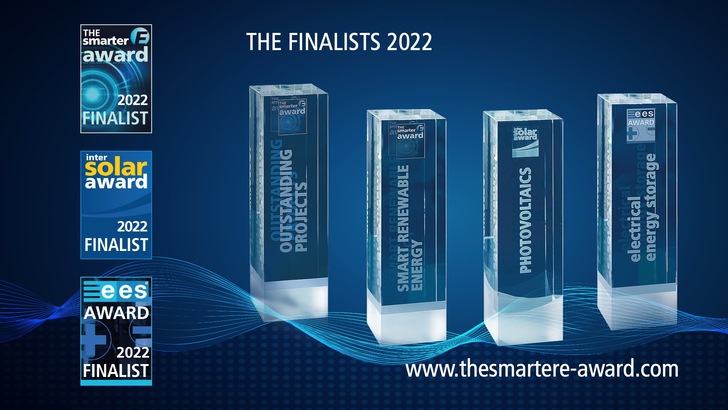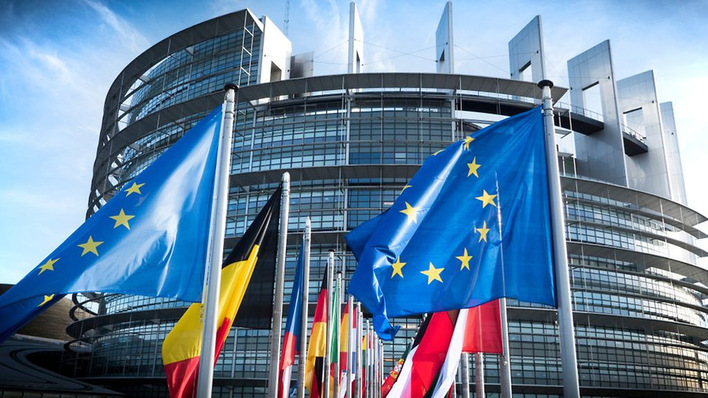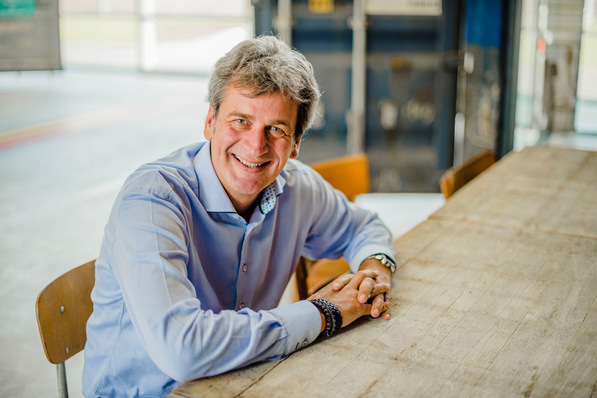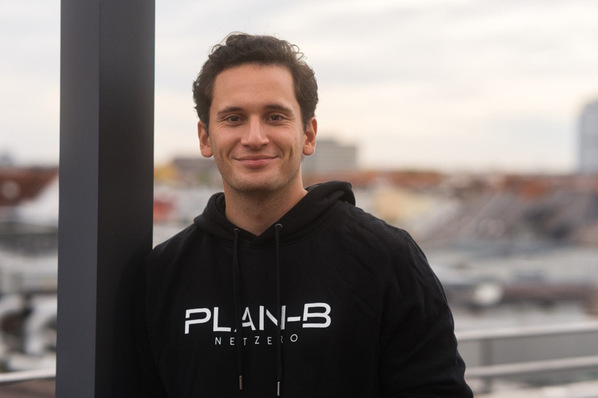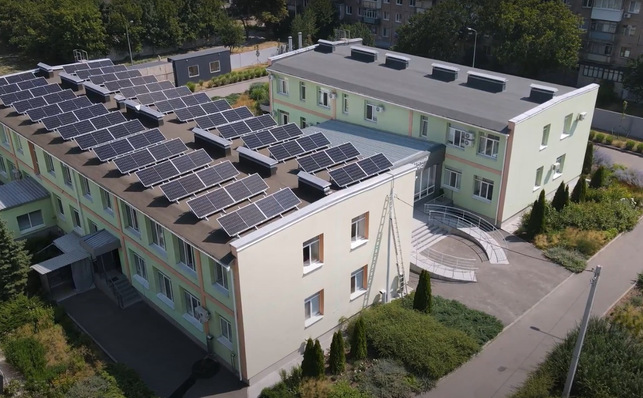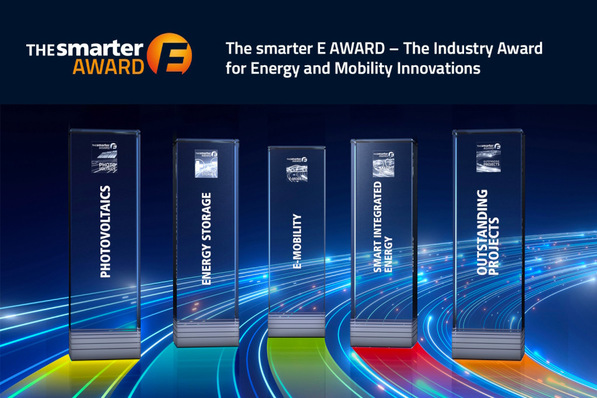The smarter E:The Smarter E Award 2022: These are the finalists The finalists for The smarter E AWARD 2022 have been named! The shortlisted organizations impressed the panel with their innovative products and projects. In the Outstanding Projects category, the nominated projects are exemplary future-oriented and unique initiatives. Meanwhile, the Smart Renewable Energy category celebrates cross-sector solutions and smart management tools for energy systems. The winners of The smarter E AWARD will be announced on May 10, 2022, as part of The smarter E Europe in Munich.
Right now, the energy industry is more important than ever before. Smart energy solutions have a vital role to play, in particular if we are going to avert the climate crisis. And that’s precisely what The smarter E Europe – Europe's largest platform for the energy industry – stands for: It showcases smart, integrated concepts and solutions to help us generate, store and use energy more efficiently. In turn, The smarter E AWARD – the renowned innovation prize of the energy industry – shines a spotlight on ideas and projects that build on developments in renewable energy, decentralization and digitalization to create smart cross-sector solutions for all areas of our electricity, heat and transport sectors.
The winners of this year’s awards will be announced on May 10, 2022, on the eve of The smarter E Europe and its four specialist energy exhibitions – Intersolar Europe, ees Europe, Power2Drive Europe and EM-Power Europe – which are taking place from May 11–13, 2022, at Messe München. The following finalists are in line to receive an award in the Outstanding Projects and Smart Renewable Energy categories.
Finalists in the Outstanding Projects category
The finalists in the Outstanding Projects category showcase exciting energy projects that can only be described as exceptional. These projects demonstrate that renewable energies and energy storage systems are gaining ground worldwide and establishing themselves as key technologies in the new energy world.
Center for Renewable Energy Services Limited (Bangladesh):
In Bangladesh, the Smart Solar Irrigation System (SirriS) supplies solar power for a series of sensor-controlled irrigation pumps and automatically controls how the water is distributed across the fields. This clever solution saves on fuel and also ensures that fields are only watered enough to maintain the necessary moisture level in the soil, thus reducing water consumption by at least 50 percent. The system can be monitored and controlled remotely and also features a special billing system, which provides farmers with operating models that deliver self- sufficiency in the long term. In short, SirriS offers economic, ecological and social benefits. The optimized irrigation process takes into account the different crop types and the pH value of the soil. Moreover, periods of high solar yield correspond with periods of high demand for irrigation, and vice versa.
Fenecon GmbH (Germany):
The stationary storage system in Werdohl, Germany, comprises a combination of new, zero-use car batteries and second-life batteries from Renault ZOE electric cars. The system is installed in containers and is used as primary control reserve for the purposes of stabilizing the grid. The aim in future is to use the battery storage capacity to also offer energy management services for industrial customers and utility companies. Inside each container unit are 72 Renault ZOE batteries – each with a capacity of 40 kilowatt hours (kWh) – connected to a storage unit with a capacity of 2.88 megawatt hours (MWh). The containers provide stable and battery-saving operating conditions.
Fenecon GmbH (Germany):
The Ma’ale Gilboa kibbutz in northern Israel is home to around 800 people. Today virtually all its electricity supply comes from renewable sources. Limited grid capacity would normally mean having to reduce the power output from photovoltaic systems and wind turbines. However, in Ma’ale Gilboa, this problem has been solved by installing a compact container storage unit with 24 BMW i3 batteries and a total capacity of 984 kWh. The main purpose of the storage unit is to cap grid feed-in peaks from the PV system. On days where solar radiation levels are high, feed-in rates no longer need to be limited, meaning the energy can be put to better use. Another advantage is that the BMW battery packs’ innovative cooling system (using a coolant) keeps the battery cells within the ideal temperature range, meaning the storage unit continues to run smoothly even when temperatures rise to more than 50 degrees Celsius outside. Conventional air cooling systems are unreliable at such high temperatures.
Fluence Energy GmbH (Germany):
This pilot project in Vilnius, Lithuania, is one of the first in the world to use a battery-based energy storage system in the transmission grid. The “GridBooster” (“NetzBooster”) storage system is highly responsive, with a processing time of 87 milliseconds and the ability to switch from charging to generation mode in just 70 milliseconds. It has been in trial operation in Vilnius since the end of 2021. Such grid boosters enable operators to make better use of the existing cable infrastructure by staggering power transmission. By installing grid boosters at strategic nodes on the grid, operators can also reduce the need for grid expansion work. For Lithuania, empowering the grid with this technology paves the way for greater energy independence and also greater decarbonization, since it allows more renewables to be integrated into the power grid.
Huawei Technologies Co., Ltd. (China):
In the Chinese city of Binzhou, a 300 MWh photovoltaic project has helped transform disused saltworks into a modern aquaculture facility. This barren patch of land is now home to China’s largest fisheries and PV integration project – a shining example of how to do green energy right, combining power generation at the top level with green farming techniques underneath. Every year, the PV plant generates around 400 million kWh of electricity, while the aquaculture facility breeds prawns. Thanks to the PV project, the water is kept clean and the right pH value and oxygen content are maintained – another great example of the synergies to be gained from effective land use.
IBC Solar AG (Germany):
E-mobility is a hot topic, but there is still a lack of charging points. This project at a car dealership in the city of Korschenbroich in Germany shows how limited grid connection capacity does not need to be a barrier to expanding the charging infrastructure. Since installing a battery storage unit and PV system, the car dealership can now operate eight charging stations, including a 50 kilowatt (kW) DC fast charging point. What’s more, all the charging points can be used at maximum capacity at the same time (around 193 kW). The combination of PV system and battery storage buffer allows for solar- optimized charging and ensures that the charging points are always available and largely carbon neutral. The project is a great example of how car dealerships around the world can pioneer the expansion of solar-powered charging infrastructure.
Reuniwatt SAS (France):
The world’s largest solar battery hybrid system in use in the mining industry has been installed at a mine in Mali. This smart PV system reduces the mine’s fuel consumption by 30 to 40 percent, which in turn reduces greenhouse gas emissions and increases the cost-effectiveness of the mine’s operations. The mine is not connected to the grid and instead has its own microgrid. An infrared sensor continuously monitors the cloud cover and generates precise short-term weather forecasts, which are used to carefully manage the use of the diesel generators and ensure that solar power is used as much as possible. This monitoring means the diesel generators do not always need to be operated in standby mode. Instead, they can be completely switched off during long periods of good weather.
Finalists in the Smart Renewable Energy category
The solutions presented by the finalists in the Smart Renewable Energy category focus on smart charging and energy management tools and cross-sector solutions to optimize the use of PV systems.
C.R. Technology Systems S.p.A. (Italy):
PR.E.SE is a passive RFID sensor for taking wireless temperature measurements in electronic devices. The sensors do not require an additional battery supply and thanks to their compact design are perfectly suited to tight installation spaces. Signals from multiple RFID sensors are captured by one antenna, and the temperature data is then displayed on a user-friendly dashboard. A machine learning algorithm identifies any temperature readings that are a cause for concern and flags these up to the system operator. One potential use of the sensors is for predictive maintenance at wind power sites or for inverters in large ground-mounted PV systems. By using the sensors to monitor the temperature of critical components, operators are able to intervene before these components fail.
deeeper.technology GmbH (Germany):
deeeper’s deep learning algorithm uses satellite images to analyze the potential of different roof-mounted photovoltaic installations. Buildings and their roofs are first located on satellite images using artificial intelligence (AI). The software then analyzes whether the rooftops are suitable for PV systems based on the surface area and any architectural features that could pose an obstacle to installation. Next, virtual PV modules are positioned on any suitable roofs and the annual energy yield estimated. deeeper helps businesses, local authorities, municipal utilities and private customers make informed decisions about investing in PV systems, and supports the solar industry in promoting their products to new customers.
Fluence Energy, LLC (USA):
The Fluence IQ software platform enables operators of renewable energy plants and storage systems to generate automated bids for their electricity supply and grid services. The software uses artificial intelligence (AI) to calculate the optimum price at which the plant operator can offer its services on bidding platforms, based on various forecasting parameters, such as weather, demand and supply over a 24 hour period. This enables operators to optimize their financial returns across their portfolio of power generation plants and storage systems, and reduce the amount of manual input needed at the control centers to keep the plant running at its optimal level.
Fronius International GmbH (Austria):
The Fronius Wattpilot is an AC charging solution that enables users to charge their electric vehicles using their own self-generated power supply and at variable electricity tariffs. Thanks to its technically advanced design, Wattpilot can automatically switch between a single phase and three phase electricity supply, meaning it offers optimized charging of electric vehicles from 1.38 kW to 22 kW. This wide power range ensures even the smallest amounts of self-generated excess energy are put to optimal use. If the electric vehicle is in sleep mode, it can also be automatically woken up and charged. In addition to using a self-generated power supply, the Wattpilot also has an in- built connection to an electricity supplier with variable electricity tariffs, which means users can charge their vehicles at times when the electricity price is particularly low (option currently available in Germany and Austria).
Next.e.GO Mobile SE (Germany):
The e.GO Next Generation is a modern and compact city car which has been designed with sustainability in mind. The car features a polymer outer shell where the color runs all the way through the material, meaning any scratches and bumps hardly show up at all. Moreover, the shell can be easily recycled at the end of the car’s lifetime since it is made of a single material. The e.GO Next Generation is produced in a microfactory that is tailored specifically to the product, meaning its environmental footprint is much lower than a conventional automotive assembly line. Energy-intensive processes such as pressing and painting are not required, and all production plants are connected via a digital network in line with Industry 4.0 principles.
Smappee nv (Belgium):
Offering up to 160 kW DC charging, the EV Base Ultra is the latest addition to Smappee’s EV product line. This innovative all-in-one solution offers users both AC and DC charging facilities, as well as modern payment options using RFID (radio- frequency identification) and QR codes. Users can also choose between CPO (Charge Point Operator) and eMSP (e-Mobility Service Provider) services. Thanks to the Smappee Infinity load and charging management system, users can manage the charging processes for the Smappee charging units and adapt them to the specific conditions on-site e.g. power output limits, self-generated power supplies and variable electricity tariffs. The Smappee dashboard also enables users to set up charging methods with different pricing tariffs and priorities.
TransnetBW (Germany):
The DA/RE (data exchange/redispatch) initiative, from the operator of the transmission grid in Baden-Württemberg, is a nationwide German initiative to encourage grid operators to take an active role in managing grid feed-in. It consists of a digital platform which is used to coordinate measures to stabilize the grid and resolve bottlenecks in a way that is decentralized, flexible and covers all levels of the grid. The DA/RE platform will enable all stakeholders to fulfill a significant proportion of the new requirements under Redispatch 2.0 by streamlining the necessary coordination process. The automated bottleneck forecasting will also make collaboration between the various stakeholders more efficient, and ultimately mean that the power grid is managed more securely and cost effectively in future. The DA/RE platform issues each grid operator with regular reports on the timetables and redispatch capabilities for each of the NABEG plants (i.e. those covered by the German Grid Expansion Acceleration Act) in their grid.
Xemex N.V. (Belgium):
The LEWIZ energy management solution (EMS) is designed to optimize energy flows within a smart home. It consists of a hardware module installed in the fuse box and a display and control app installed on the user’s smartphone. The EMS controls and manages the use of consumers and generation units such as heat pumps, electricity storage systems and PV systems, as well as the charging of electric vehicles, in order to maximize their cost-effectiveness in line with given criteria (e.g. maximizing the use of self- generated energy or taking advantage of variable electricity tariffs). The manufacturer- independent solution is offered with a 10-year service contract. (hcn)
Further information on the awards can be found at:
www.TheSmarterE-award.com
www.intersolar-award.com
www.ees-award.com

